Spring is a time of energy, rejuvenation and budding life — yet also of accidents and injuries, especially in your own yard. In the U.S. alone, one person is injured from an accidental event roughly every second. Come springtime, these common yard work injuries take many forms. From slips or falls to strains, slashes, cuts and burns, nearly all spring yard work injuries are preventable.
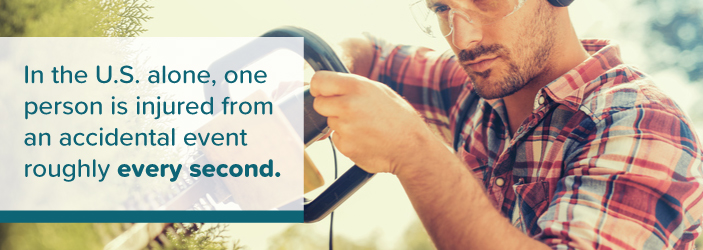
Accidents happen, even among the most cautious individuals. If spring yard work accidents are the malady we all wish to avoid, then safety and forethought are the antidotes.
With a little prudence and a lot of care, you can ensure avoiding yard work injuries throughout the spring and beyond with these tips and tools.
Common Yard Work Injuries in Spring
We understand. After being cooped up indoors through long, listless winter months, you can’t help but plan and prep for a new, thriving lawn and garden come spring. You also may be ready to do exterior work on your home itself, from the ornamental and decorative to functional repairs or much-needed makeovers.
Yet folks are most prone to accidents when they rush or underestimate the thoroughness of their yard-work tasks. Ensure you don’t fall prey to the following standard springtime injuries, ranging from the inconvenient to the severe and everything in between.
Common Yard Work Injury: Straining or Pulling Muscles
When it comes to yard work, there are few injuries as prevalent as strained or pulled muscles. Strained muscles don’t discriminate. They affect people of all ages, fitness levels and physical builds, often striking inflexible or improperly stretched muscles groups that displayed no prior signs of rigidity.
For spring yard work, consider all the tasks that require bending, pulling and shifting body positions. From digging new garden beds to clearing and raking debris to pulling weeds to pushing heavy lawnmowers, strained and pulled muscles can occur across the gamut of yard work activities.
The lower and upper back, as well as shoulders and hips, are the most prone to pulls and strains. Shoulder pain or hands shaking after mowing your lawn is common, but listen to your body as you work. Never overexert yourself or rush to get yard work done at the expense of your health.
Common Yard Work Injury: Ladder or Roof Falls
Spring yard or housework often means pulling out the ladder. Correctly using a ladder to clean gutters or prune dead or diseased tree limbs will not only ensure the smooth accomplishment of yard projects but also keep them injury free.
After all, more than 164,000 people are injured from falling off a ladder, with an accompanying and pricey emergency room visit promptly following. Ladder injuries can cause mild to serious problems, such as bruises and broken bones or concussions and spinal damage.
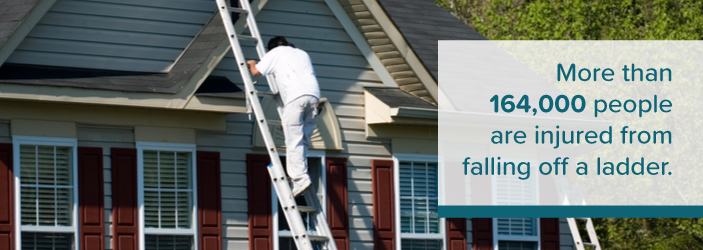
Many people conduct roof work once spring’s warm weather arrives. Whether the job includes clearing debris after a storm or conducting a roofing material maintenance check-up, roofs can be cumbersome to maneuver around for even short periods of time.
Ladder and roof falls are most prevalent when ladders are set up improperly, propped on uneven ground or placed in unstable environments. What’s more, using old or ill-maintained ladders without proper safety features and extensions further encourages an accident to occur. Keep young children out of a fixed ladder’s reach as well so no climbing and goofing around can happen, even on the most secure-seeming ladders.
Common Yard Work Injury: Lawnmower Burns or Cuts
It’s a satisfying feeling to get outside and rev up the lawnmower after winter has kept it dormant. Growing that dream green lawn is a pivotal piece of spring yard work and something many people look forward to undertaking. Few operations stand as crucial in this process as mowing and trimming fresh and healthy grass.
Yet lawnmowers present a range of safety hazards, especially right after their winter hibernation. Engines are prone to stalling due to:
- Improper, stale fuel
- Rusted spark plugs
- Damaged carburetors
What’s more, a lawnmower’s blades are likely to be dull and offset from lack of care in the offseason.
Reviewing and addressing these concerns has been known to cause many injuries, from cuts when sharpening lawnmower blades to amputating toes and fingers. Ricocheting debris is another primary lawnmower injury concern. When using a lawnmower in early spring, yards are often littered with rocks, clumps and other materials that momentarily jam a lawnmower, only to shoot out unexpectedly.
Lawnmower engines and exhaust can also reach surprisingly high temperatures. A recently used lawnmower will need time to rest and cool and should not be touched. Furthermore, if you run out of fuel while using a lawnmower, give the machine a proper rest period before you add any new gasoline to the tank to avoid burns and fires.
Common Yard Work Injury: Tractor Woes
From compact utility tractors to large agricultural units, tractors are another common source of yard work injuries. They’re similar to lawnmowers in that many overlook basic safety and maintenance elements, mainly for personal units used to maintain private, residential acres.
Tractor injuries include muscle strains, bruises, bone fractures and breaks due to rollovers, collisions or attempting to fix entangled parts. Rollovers account for the majority of tractor-related injuries, occuring when tractors are driven in hazardous weather conditions or maneuvered across uneven terrain.
When tractor gears, pulleys, chains and other mechanical systems become locked or entangled, many are tempted to solve the problem immediately, whether or not the proper tools and safety gear are available. Hands and fingers can quickly get caught in jerky systems or trapped inside machine parts, leading to further critical injuries.
Common Yard Work Injury: Hedge Clipper Cuts and Slices
Trimming and pruning landscaping is another spring yard necessity. Yet hedge clippers themselves can be sharp and heavy objects with a number of safety concerns during spring use.
From manual clippers to more contemporary battery-powered tools, yards with large bushes and hedges often require a hedge-clipping routine. Cuts and lacerations usually take place when mishandling or losing control over a clipper. This is especially common with older, rusty or poorly maintained trimmers without smooth, even applications or designs that are clunky to handle. Young children are especially prone to clipper cuts, unfamiliar with the tool and its proper handling.
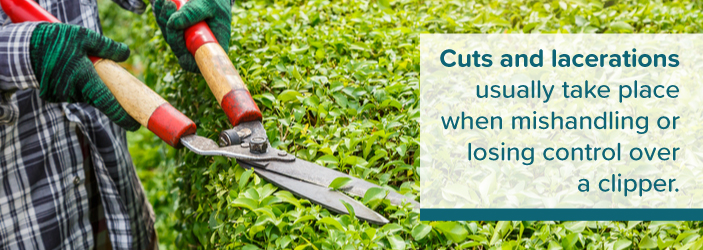
In the most extreme cases, fingers and toes can be severely sliced or even amputated in the event of a hedge trimmer injury. People have lost control over electric or battery-powered clippers and subsequently dropped their tools onto limbs. Still others have been injured due to a device or manufacturing glitch causing the tool to run uncontrollably.
Common Yard Work Injury: Chainsaw Issues
Like hedge clippers, chainsaws are a necessity for yards and landscapes with heavy bramble, thick, woody shrubs and dense treelines. They can also be hefty to operate and dangerous in negligent hands, needing maintenance care and attention to run accurately and minimize the risk of injuries.
In lucky cases, chainsaw-related injuries include muscle cramps from handling the tool too long, as well as strains and spasms that result from chainsaw’s vigorous vibrations. Chainsaws come in various sizes and power levels, and not using the appropriate one for the job is a sure way to set yourself up for this kind of muscle strain.
In severe cases, individuals lose control of chainsaws and risk grave bodily harm. Chainsaws should always remain out of reach from pets and children whether in use or not, plus securely stored when off.
Common Yard Work Injury: Insect Stings
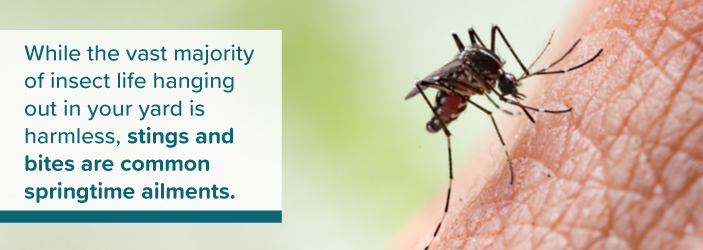
Spring brings out new flowers, grasses and plantings — but it also brings out the bugs. While the vast majority of insect life hanging out in your yard is harmless — if not beneficial — stings and bites are common springtime ailments that can lead to more severe complications.
Note how your body reacts to various insect and bug stings, such as painful and swollen muscles or allergic reactions. The most common spring-insect stings come from:
- Bees
- Wasps
- Hornets
Ant bites are also standard, as are budding mosquito and fly populations.
Doing yard work can inadvertently bring you into direct contact with insect homes and hives. As with everything on this list, use caution when working with insects to avoid any significant harm — to yourself and your beloved yard.
Spring Yard Work Safety Tips
Avoiding yard work injuries is as much about patience and proactivity as it is common sense. The surest way to prevent injuries when working outside this spring is to take your time with any planned or pop-up projects. Take inventory of tools and equipment. Survey the condition of all manual or battery-powered devices you plan to use, and conduct maintenance on them beforehand. Set up a proper, contained workspace and only go outside in good weather conditions.
Most importantly, listen to your body. Fatigue and pains are not signs of weakness or project inconveniences but direct messages from your nerves to lighten it up just a little. You can further prevent yard work injuries by following these safety tips and procedures.
Wear Proper Yard Work Gear
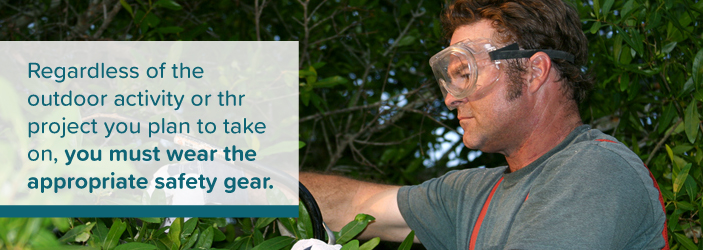
Regardless of the outdoor activity or thr project you plan to take on, you must wear the appropriate safety gear. Not doing so significantly increases your likelihood of injury, especially with do-it-yourself yard projects.
In fact, experts often see injuries occur as a direct result of people assuming protective gear wasn’t necessary for their “small” outdoor tasks. Those injured cite the fact they don’t see others around them wearing safety or protective clothing, from next-door neighbors to on popular renovation TV shows. In avoiding yard work injuries, make sure to slip on the following gear the next time you’re outside.
- Closed-Toe Shoes. Sandals and flip-flops are notoriously poor choices for yard work. Wearing closed-toe shoes is especially keen when doing activities like mowing the lawn or climbing ladders, as they’re far less likely to slide and shift and have your foot pop out.
- Slip-Resistant Footwear. Take the extra step and buy slip-resistant workboots or shoes. This specialty footwear comes designed with adhesive outsoles and tripguard ridging for the safest possible design. Some brands even carry OSHA-approved safety stamps that are industry leaders for ladder-climbing and rooftop work.
- Long Pants. Wearing long pants seems obvious, but it’s a common oversight on a warm spring work day. Shorts simply won’t protect you from cuts, scrapes and ricocheting debris.
- Gloves. Wear gloves during yard work as a final protective layer. You can choose from rubber or leather, insulated and Kevlar-reinforced. Since your hands are likely doing most of the work, make sure you have them covered.
Read Machine Manuals
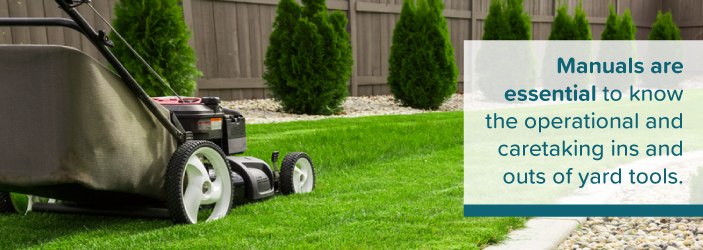
Another obvious yet overlooked safety procedure? Reading the manual for all tools and equipment required for your yard work. They may not be page turners, but manuals are essential to know the operational and caretaking ins and outs of yard tools.
You can even brush up on machine manuals in the offseason. That way, once spring arrives, you can dive into your residential projects and save yourself time without skirting any safety precautions.
Use Ergonomic Tools Whenever Possible
Ergonomic tools are designed to be as comfortable and user-friendly as possible. When handled correctly, they significantly decrease the forces on your body that come with operating electrical power tools.
Other bodily risk factors ergonomics account for include:
- Healthier posture when using tools
- Less wear from repetitive and high-force motions
- Lowering the impact of a device on your body
- Any hand-arm vibrations
Altogether, you can’t beat the engineering of ergonomic tools to prevent injuries and keep you feeling great.
Maintain Proper Ladder Safety
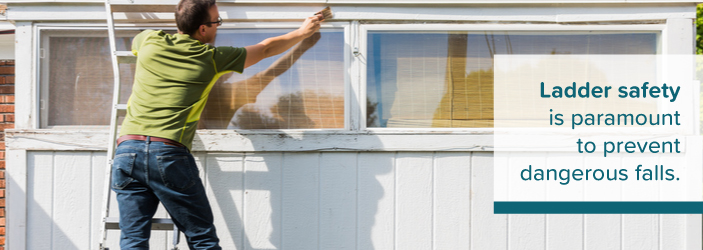
Ladder safety is paramount to prevent dangerous falls. Luckily, there are a number of assessments you can enact on your household ladder to guarantee it’s up for yard work:
- Check all ladder safety features and devices for quality and condition.
- Wipe excess moisture or dirt off all ladder rungs before using.
- Only place ladders on smooth, uniform ground surfaces.
- Incline your ladder at appropriate, safe angles, be it a single or extension ladder.
- Do not attempt to move or shift the ladder while you or anyone else is on it.
In addition, only use a ladder during temperate weather, ideally during the day or in a well-lit night workspace. Employ ladders meant for the specific job type on hand, and don’t overextend your ladder’s height by propping it on any objects.
Last but not least, always use the three-points-of-contact rule. That is, keep three points of bodily contact on the ladder at all times, whether that’s two hands and one foot or two feet and one hand.
Take Breaks
There’s no need to strain yourself working out in the yard. Doing so will not only court physical injuries, like knee, wrist or back pain, but also result in mental strain and fatigue, as well. Plus, you’re far less likely to do quality work in your yard if rushed or stressed for time or generally feeling poorly.
Hot or humid spring days, in particular, mean slowing down and planning ahead. It’s your space, and at the end of the day, you’re the boss. Take care not to push yourself to the point of injury.
Stretch Before and After Yard Work
Long hours weeding and planting garden beds or pushing heavy mowers will take their toll on muscles and joints. The simplest solution? Stretch before heading out and right after you’ve wrapped up.
Stretching does wonders for the body, including preparing it for the movements done while working in the yard and cooling it down once finished. Take care not to stretch for too long, though. Prolonged static stretches, such as those exceeding 60 seconds, can actually pull muscles and increase the likelihood of contractions, strains and tears.
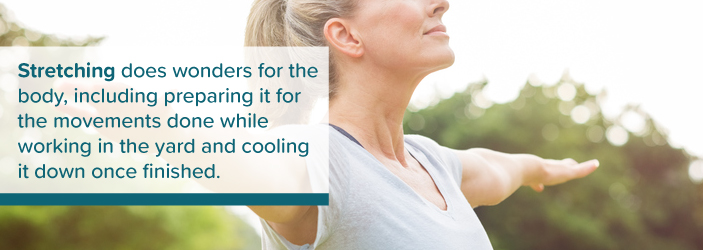
Opt for three rounds of 20-second stretches targeting one or two muscle groups at a time, such as hamstrings, shoulders, hips and the lower back. Increase circulation and loosen hands, wrists and legs by shaking them out leisurely before and periodically during yard work.
What To Do in the Event of an Injury
Even with proper care and preparation, injuries happen. Don’t let additional problems compound by ignoring or neglecting pains, cuts or aches if they occur, and never be afraid to consult with an expert if physical ailments continue.
Stop Working After a Yard Injury
To prevent minor injuries from becoming major ones, hit pause on yard work as soon as you experience any impairment. Assess the situation for immediate pains and swelling. Take care of the most pressing concern first, such as open cuts from yard tools or blades.
If possible, try to avoid doing yard work when home alone. Having someone else around ensures immediate help is available in the event of an injury.
Apply Ice to Your Yard Injury
Have an ice or cold pack read in the freezer to apply to any swollen or affected areas. Keep the ice pack on hand for the next 48-72 hours, icing inflammation for no longer than 20-minute periods. Reuse the pack at multiple intervals throughout the day.
Clean and Bandage Wounds Incurred in the Yard
If experiencing open cuts or nicks that are bleeding, thoroughly clean the wound and wrap in a bandage. Swap out old for new dressings roughly every 24 hours.
Seek Pain Relief for Your Yard Work
If necessary, take mild pain-relief medications like ibuprofen or aspirin. Follow all label instructions and keep stored in a cool, dry but readily accessible place.
Orthopedic Solutions for Spring Yard Work Injuries
For pain relief and care that goes beyond what you can achieve on your own, consider orthopedic services after a spring yard injury. Utilizing these specialty services post-injury will not only encourage a smoother recovery — they guarantee holistic treatment while delivering peace of mind. Consider using our orthopedic specialists’ resources for preventing a spring yard work injury.
Professional Expertise
Consulting with an orthopedic medical profession will ensure the right diagnosis and treatment for any physical injury, big or small. There are nearly a dozen orthopedic subspecialties as well, meaning whatever area of your body has sustained an injury will be matched with an expert in that field. Ultimately, you get the right health and wellness decision to put your mind — and body — at ease.
Physical Therapy
For more severe injuries, physical therapy is a helpful consideration. Both short and long-term physical therapy options exist. Your orthopedic doctor and physical therapists can package individualized treatments to target your health needs, from restrengthening soft tissue to joint mobilization.
Medical Acupuncture
Medical acupuncture has a long and scientifically accredited history for pain relief and management. It is a safe and effective procedure that promotes your body’s own natural healing processes, synthesizing eastern and western medical traditions. Many orthopedic practices have medical acupuncture services you can look into, especially if experiencing long-term pain well after a yard work injury.
Cortisone or PRP Injections
For severe, recurring pain or inflammation that’s affected the quality of your daily life, orthopedic doctors may suggest cortisone injections or other targeted spot treatments, such as platelet-rich plasma (PRP).
These injections encourage a direct and rapid alternative treatment for physically injuries and chronic pain. They’re often an option when other treatments aren’t seeing the desired, effective results, or the pain you experience from an injury is fundamentally affecting the way you live your life.
Interventional Pain Management and Care
The most serious orthopedic care might blend treatment styles. After a severe yard-related injury — such as a bad fall or torn rotator cuff — you may need a combination of conservative and advanced treatments to not only manage but address and heal lasting damage.
Visit the Orthopedic Experts Across Central Pennsylvania for Your Yard Injury
When it comes to addressing, managing and healing yard work-related injuries, you don’t have to look far. The Orthopedic Institute of Pennsylvania (OIP) has eight locations throughout Central Pennsylvania to bring the quality care and knowledge you need in the event of an injury.
We know the toll pain can take on your life. We also know you don’t have to live with it. With over 40 board-certified orthopedics and physicians assistants in our network, we give you the expertise, specialization and attention your injury requires.
View our orthopedic providers today, and learn more about the complete musculoskeletal system services offered at OIP.


